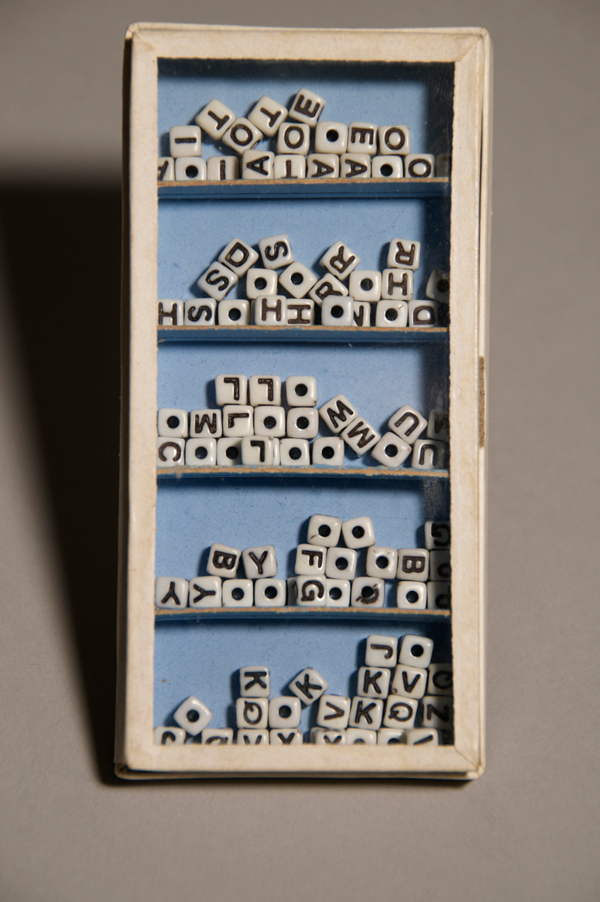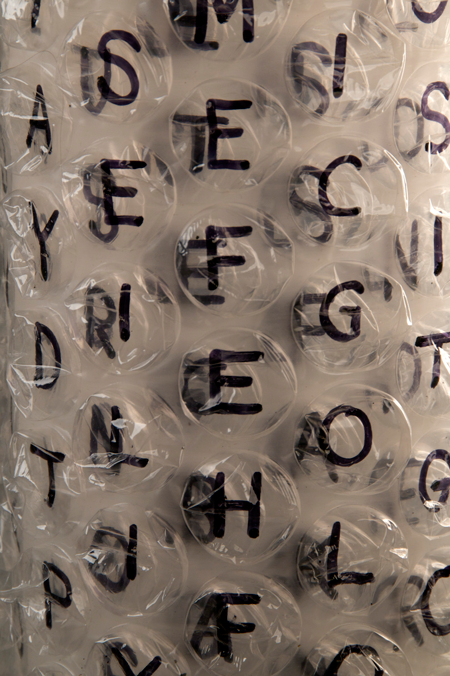David Abel

David Abel, Zetaqop Ladder (for Alison Knowles), 2011, Glass beads in Parisian hairpin box. Photograph by Kerry Davis. Image courtesy artist.

David Abel, Molecular Text #2: Solids, 2011, Sharpie marker on bubble wrap. Photograph by Kerry Davis. Image courtesy artist.

David Abel, Molecular Text #2: Solids (detail), 2011, Sharpie marker on bubble wrap. Photograph by Kerry Davis. Image courtesy artist.
Zetaqop Ladder (for Alison Knowles) and Molecular Text #2: Solids were created for the 2011 exhibition Object Poems at 23 Sandy Gallery in Portland, Oregon.
The processes under development and on display in these works can be taken in many ways. Two approaches that seem especially apt to point out: an intervention in the rules governing the representation of a text by constituent parts; and a concretization of the figurative character of writing, a literalization of the nonliteral. Here I’m taking my senses of “figurative” and “literal” from Owen Barfield’s Speaker’s Meaning (Wesleyan, 1967):
It is that all language has been, and some still is, imagery, in the sense that one meaning is apprehended transpiring through another . . . Nonfigurative language, on the other hand, is a late arrival. What we call literal meanings . . . are never samples of meaning in its infancy; they are always meanings in their old age — end products of a historical process.
In the Zetaqop Ladder I make use of an alternative ordering of the letters of the English alphabet, which I call the zetaqop: z q x j k v b p y g f w m u c l d r h s n i o a t e. (Happily, this sequence fits quite well into the familiar alphabet song. Try it; the only difficult part is Now I know my zqxjkvb’s.) The letter beads have been sorted into “tranches,” ascending through the zetaqop. Their indeterminate positions within the tranches allow for a performative interaction with the object, which in consequence makes a pleasing sound; these qualities are in homage to the work’s dedicatee. The resulting assemblages may be subversions of such categories as word and sentence; or they may just be heaps of shards.
Molecular Text #2: Solids is the second in an ongoing series of realizations — inscriptions, republications — of preexisting texts. Subjecting the texts to this literal spatial condition strikes me at times as dumb, reductive; the “space of literature” is infinitely richer than my models. Yet as a proofreader and ex-typographer (and observer of omnipresent ambient visual language), I still thrill to see the letters reassert their autonomy and heterodox associations.
The text in this instance is an excerpt from Bill Berkson’s essay “The Elements of Drawing,” originally published in the catalogue for an exhibition of still-life drawings by Wayne Thiebaud, and collected in For the Ordinary Artist: Short Reviews, Occasional Pieces & More (BlazeVOX, 2010):
Height, width, depth — the more easily solved mysteries of solids — leaving the greater essentials, the energy of whatever’s visible engraved in its portion of air and light, on hold. Indelible, even so, my adolescent pleasure in discovering, during otherwise alien geometry lessons, receding parallel lines that, if you extended them from any given rectangle and connected the strokes, line angled to line, would produce by sleight of hand a box, brick or room-like setting. Or, in a rapture of perpendicularity, stack box over box, and several parallelograms worth of doorways, and presto, a city, ancient or modern as you like, ready for occupancy. Or so it seemed, from sixth grade onward.
The artist extends grateful acknowledgment to Laura Russell at 23 Sandy; to Kerry Davis for the photographs; and to Bill Berkson for permission to reprint his text.
Poet, editor, teacher, and bookseller David Abel is the author most recently of the New Year’s chapbooks Elysian Ellipses and Shawarma Tractor. Three new books appeared in the summer of 2012: Float, a collection of collage texts spanning twenty-five years (Chax Press); Tether, a chapbook of poems (Barebone books); and Carrier, a hypergraphic visual sequence (c_L Books). He has devised more than thirty performance, film, theater, and intermedia projects in the past decade, both solo and with a wide range of collaborators. A founding member of the Spare Room reading series, entering its thirteenth year, with Sam Lohmann he publishes the Airfoil poetry chapbook series. He was an inaugural Research Fellow of the Center for Art + Environment of the Nevada Museum of Art, and is the proprietor of Passages Bookshop; in 2013 he curated the exhibitions Chax Press: Publishing Poetics for Pacific NW College of Art and in 2011 Object Poems for 23 Sandy Gallery in Portland, Oregon.